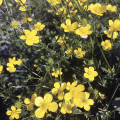Renovating Ponds
Renovating Ponds
Starting Over
The ultimate fate of many farm ponds is an unbalanced fish population that is undesirable to anglers and has little recreational fishing value. Once a fish population reaches such a condition, the best solution is usually to eliminate the resident fish and restock with a desirable combination of fish at recommended rates.
The easiest way to renovate a pond is to drain and completely dry the pond. This also lets you modify the pond or add habitat. If any pools of water remain in the basin, drain or poison them, because small fish can survive in these pools for a very long time and ruin your renovation attempts.
Also, many ponds were not constructed with a drain, and all of the water cannot be removed. These ponds will need to be chemically renovated. Rotenone is a fish toxicant registered by the Environmental Protection Agency for removing unwanted fish.
What Is Rotenone?
Rotenone is available at most farm and chemical supply stores. It is classified as a “restricted-use pesticide,” and you cannot buy it without a private pesticide applicator’s certificate. You can get this certificate through your MSU Extension county agent.
Rotenone comes from the roots and stems of several tropical plants. Rotenone keeps fish from using oxygen, but it does not remove oxygen from the water. Fish in ponds treated with rotenone move to the shallow water or to the surface of deeper water soon after exposure to the chemical. Fish species respond differently to rotenone, so it is a good idea to know what species you have before you treat the pond.
Rotenone breaks down when exposed to the environment. The breakdown is rapid and is affected by temperature, light, oxygen, and alkalinity. Most waters are safe for restocking within 5 to 6 weeks. In general, the cooler the water, the longer rotenone lasts.
Preparing the Pond
You can treat ponds of any size with rotenone, but it can be difficult to spread rotenone for an effective fish kill in larger ponds or lakes. It is also expensive to treat large volumes of water. For these two reasons, you will need to reduce the water area and volume as much as possible before treating. You can do this by draining the pond as low as possible with a built-in standpipe, pump, or siphon device. The less water you have to treat, the more cost-effective the treatment. Also, lowering the water level pulls fish out of their shallow water cover that can be difficult to treat.
How to Apply Rotenone
Rotenone is available in powder and liquid formulations. Liquids are easier to get into solution and are more reliable for total fish kills. The liquid formulations typically contain 5 percent rotenone, although some contain 2.5 or 7 percent.
Treatment rates for a complete kill vary between 0.1 and 3 parts per million rotenone, depending on the objective of the pond renovation and the species present. All formulations must be diluted with water and evenly distributed throughout the water column. You can spray the chemical over the pond surface or drip it into the prop wash of an outboard motor. The key is to have an even distribution; otherwise, fish may find “safe” areas and not be killed. Application in a random “S” pattern throughout the pond maximizes coverage.
The best time to eradicate fish from a pond for restocking is late summer or early fall. Water temperatures are at their highest at this time, and the weather is usually dry, allowing easy draining. Killing the fish at this time reduces the time between the kill and the restocking, which minimizes the chance the pond will be contaminated by unwanted fish before restocking. This is an important consideration, since letting in unwanted species can defeat the purpose for the renovation.
If you drain the pond, it is critical to poison all remaining puddles to kill any fish there. Many small fish can survive in these pools, puddles, or stump holes for a long time. You must kill all fish to have a successful renovation. Otherwise, these surviving fish can contaminate the new fish population, and the renovation will have been for nothing.
When to Restock
It is important to wait until the rotenone dissipates before restocking. If you poison in early fall, the rotenone should be detoxified by the time early winter rains come to refill the pond. A good general rule is to wait 1 month. A simple test can help determine when it is safe to restock. Place a few bream (bluegill or redear) in a small cage in the pond or in an aerated container with water from the pond. If the fish survive 24 to 36 hours, it is safe to restock the pond. Do not release these fish into the pond unless they are part of your restocking plan!
Publications
News
Whether you have a large lawn, field, or pasture, you’ve probably had to deal with pesky weeds.
BILOXI, Miss. -- The Southeast has some of the most commercially and recreationally valuable fisheries in the United States.
Success Stories
Billy Mitchell spent his childhood summers in the water and has lived at Pelahatchie Bay for more than three decades, so his dedication to protecting water resources now almost makes too much sense.






